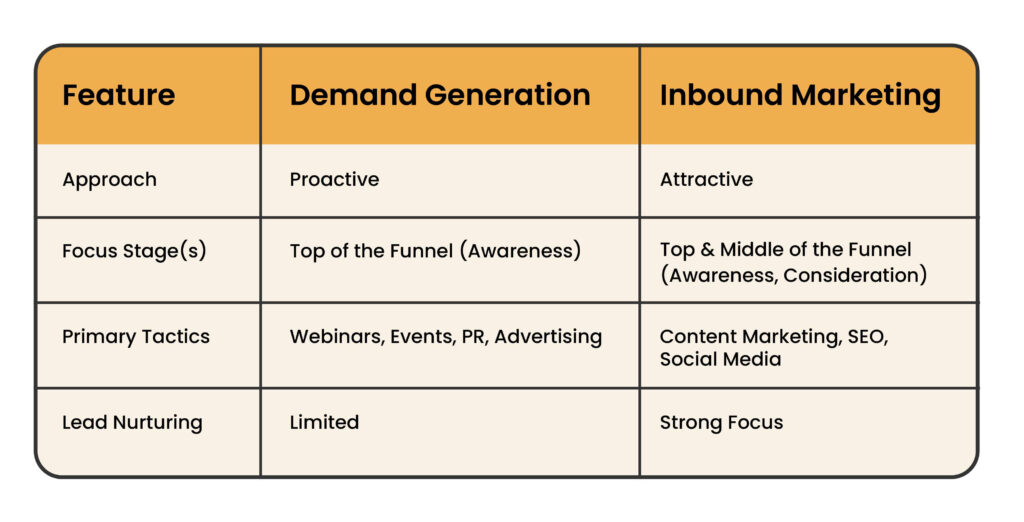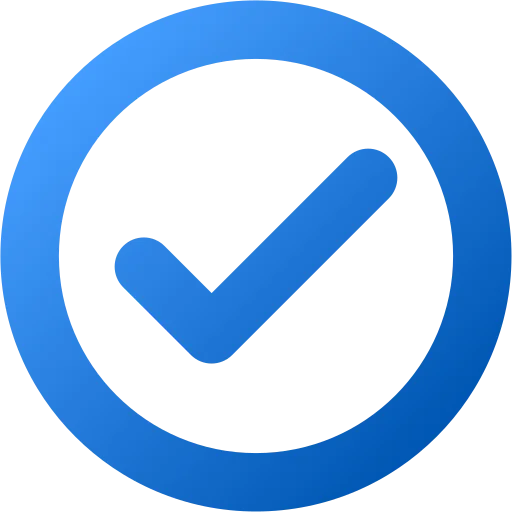
Among marketers, few topics spark as much debate as the comparison between demand generation and inbound marketing. But what truly sets them apart?
In the demand generation, marketers use a mix of active strategies (webinars, email marketing, paid ads) and passive strategies (content marketing, SEO, podcasting, social media marketing) to capture prospects’ interest in making a purchase. Conversely, inbound marketing predominantly relies on passive techniques to draw in potential leads.
So, what’s the best way forward?
The answer lies in understanding their respective strengths and how they complement each other within your marketing plan. But before we dive into that, let’s break down each in detail.
Must Read: 5 Common B2B Demand Generation Pitfalls to Avoid
What is Demand Generation?
Table of Contents
- 1 What is Demand Generation?
- 2 Where do Demand Generation and Inbound Marketing Fit in the Marketing Funnel?
- 3 Only B2B Takeaway: Modern Demand Generation and Inbound Marketing
Demand generation includes strategic efforts focused on building market awareness, igniting interest, and driving demand for your products or services. It’s a continuous process focused on reaching and engaging potential buyers outside of your existing market.
In essence, demand generation involves actively shaping market perceptions and generating excitement about what you offer.
Key demand generation marketing tactics include:
- Social media marketing
- Community building
- Blogging
- Podcasting
- Live events
But how do you measure the success of inbound marketing efforts? Here are some metrics to consider:
- High-intent Marketing Qualified Leads (MQLs).
- Contribution to pipeline and sales impact.
- Brand awareness and visibility.
- Lead generation and qualification.
Benefits of Demand Generation:
Increased Qualified Leads:
By creating widespread awareness and interest, demand generation activities attract a larger pool of potential customers, ultimately leading to more qualified leads entering your sales funnel.
Enhanced Brand Recognition:
Effective demand generation strategies elevate your brand profile, positioning you as a thought leader and a trusted resource within your industry.
Improved Sales Pipeline:
A steady flow of qualified leads translates into a robust sales pipeline, empowering your sales team to focus on closing deals.
What is Inbound Marketing?
Inbound Marketing, on the other hand, focuses on attracting potential customers through valuable content and building trust. It’s akin to setting up a magnet – where compelling content pulls in ideal customers towards your business.
Popular tactics for inbound marketing include:
- Gated content
- Webinars
- Content syndication
So, how do you measure the success of inbound marketing efforts? Here are some key metrics to consider:
- Website traffic.
- Strong MQL to SQL conversion [lead nurturing].
- MQL through inbound channels (e.g., blog downloads, content offers).
Must Read: 9 Demand Generation Books Every Marketing Expert Should Read
Benefits of Inbound Marketing:
Cost-Effective:
Inbound marketing leverages organic strategies like SEO and content marketing, offering a cost-effective way to attract leads compared to traditional outbound advertising.
Targeted Audience:
By creating targeted content aligned with your ideal customer’s interests and pain points, you attract a more qualified audience, increasing the conversion rate.
Nurturing Leads:
Inbound marketing allows you to nurture leads through the buyer’s journey by providing valuable information and resources, building trust, and ultimately guiding them towards conversion.
Must Read: How to Qualify Inbound Leads?
Key Differences between Demand Generation and Inbound Marketing:
Here’s a table summarizing the key differences between Demand Generation and Inbound Marketing:

Using Demand Generation and Inbound Marketing Together
While they have distinct approaches, demand generation and inbound marketing are not mutually exclusive. In fact, they work best when integrated into your marketing strategy.
Demand Generation paves the way:
By creating initial brand awareness and interest, demand generation activities attract potential customers who are then receptive to the valuable content offered through inbound marketing.
Inbound Marketing nurtures leads:
Once potential customers are drawn in by compelling content, inbound marketing tactics nurture them through the buyer’s journey, building trust and guiding them towards conversion.
Marketing Automation streamlines the process:
Marketing automation tools can be leveraged to personalize the buyer’s journey and seamlessly integrate demand generation and inbound marketing efforts.
While knowing the right strategies is crucial, but their effectiveness relies on their alignment with the appropriate stages of the marketing funnel.
Let’s learn how:
Where do Demand Generation and Inbound Marketing Fit in the Marketing Funnel?
Top of the Funnel (Awareness):
Demand generation strategies such as webinars, industry events, and PR campaigns are primarily aimed at this stage. They help create brand awareness and generate interest among potential customers.
Middle of the Funnel (Consideration):
Inbound marketing tactics, including SEO, social media marketing, and content marketing (such as blog posts, e-books, and whitepapers), play a crucial role here.
These strategies attract qualified leads and provide them with valuable information to help them consider your solutions.
Bottom of the Funnel (Decision):
Both demand generation and inbound marketing contribute to conversion at this stage. Targeted email campaigns and personalized demos can be effective in nudging leads towards making a purchase decision.
In a nutshell, integrate both approaches! Leverage demand generation to create a buzz and attract potential customers, then nurture them with high-quality content and targeted messaging through inbound marketing.
Must Read: Account Based Marketing An Important Aspect of Demand Generation Channel
Only B2B Takeaway: Modern Demand Generation and Inbound Marketing
By understanding the unique strengths of demand generation and inbound marketing, you can craft a winning marketing strategy that attracts qualified leads, strengthens your brand image, and ultimately fuels your sales pipeline. Remember:
Focus on synergy: Don’t view these as competing forces, but rather as complementary strategies that work best when combined.
Measure and adapt: Continuously monitor your marketing performance and adapt your approach based on data and results.
Embrace the future: Stay informed about emerging marketing trends like marketing automation, artificial intelligence, and personalized content experiences.
By implementing these insights, you can position your business for long-term success in today’s dynamic marketing landscape. Looking for even more personalized guidance? Contact us to discuss your specific B2B marketing goals and explore how we can help you achieve them.

Vikas Bhatt is the Co-Founder of ONLY B2B, a premium B2B lead generation company that specializes in helping businesses achieve their growth objectives through targeted marketing & sales campaigns. With 10+ years of experience in the industry, Vikas has a deep understanding of the challenges faced by businesses today and has developed a unique approach to lead generation that has helped clients across a range of industries around the globe. As a thought leader in the B2B marketing community, ONLY B2B specializes in demand generation, content syndication, database services and more.

.webp)
